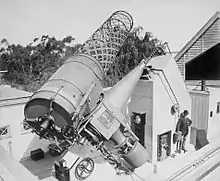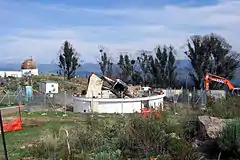Great Melbourne Telescope
The Great Melbourne Telescope was built by the Grubb Telescope Company in Dublin, Ireland in 1868, and installed at the Melbourne Observatory in Melbourne, Australia in 1869. In 1945 that Observatory closed and the telescope was sold and moved to the Mount Stromlo Observatory near Canberra. It was rebuilt in the late 1950s. In 2003 the telescope, still in use as an observatory, was severely damaged in a bushfire. About 70% of the components were salvageable; a project to restore the telescope to working condition started in 2013.
 The Great Melbourne Telescope being installed in 1869 after it was shipped in pieces from the works of Howard Grubb, Dublin. | |
| Part of | Melbourne Observatory Mount Stromlo Observatory |
|---|---|
| Location(s) | Victoria, AUS |
| Coordinates | 37°49′47″S 144°58′34″E |
| Telescope style | optical telescope |
 Location of Great Melbourne Telescope | |
| | |
With a 48 inch (1.2 metre) diameter primary mirror, it was one of the largest telescopes of the late 19th century. This is a significant size even into the 21st century, although the lower reflecting ability of speculum metal mirrors (about 2/3 reflected) makes them inferior to later metal-on-glass designs or large refractors. This was significantly larger than the largest refractors of the period such as the Lick telescope and Yerkes, although those were both in the northern hemisphere (they would view the northern skies as opposed to the southern)
Specifications
The telescope had a 48-inch-diameter (1,200 mm) speculum primary mirror, and was mounted on an equatorial mounting, enabling it to track the stars accurately as they appeared to move across the sky. The design had been approved by a committee of leading British astronomers and scientists.[1] At the time of commissioning it was the second largest telescope operating in the world, after Lord Rosse's 6 foot reflector at Birr, Ireland, and it was the largest fully steerable telescope in the world.[note 1]
The telescope was designed to explore the nebulae visible from the southern hemisphere, and in particular to document whether any changes had occurred in the nebulae since they were charted by John Herschel in the 1830s at the Cape of Good Hope.[2]
History

The Great Melbourne Telescope was built by Thomas Grubb in Dublin, Ireland in 1868, and installed at the Melbourne Observatory in Melbourne, Australia in 1869.[3][4][5]
After some initial teething problems, the telescope was used for about 20 years at Melbourne Observatory, and one volume of observations produced, along with spectroscopic observations and some pioneering attempts at photographing nebulae. The telescope was upgraded with the addition of photographic equipment in 1872,[6] but the difficulties of repolishing the mirror and the telescope's relative unsuitability for astrophotography deterred further use.[7]
When Melbourne Observatory closed in 1945, the Great Melbourne Telescope was sold to the Australian Government's Mount Stromlo Observatory near Canberra. It was rebuilt in the late 1950s with modern drive and a new 50-inch (1,300 mm) pyrex mirror. In the early 1990s the telescope, still utilising Grubb's original equatorial mounting, was rebuilt with two charge-coupled device (CCD) arrays to detect MACHOs (massive astrophysical compact halo objects). This made it Australia's first professional robotic and computerized digital imaging telescope.[8][9]
Destruction

In January 2003 an extreme bushfire destroyed the telescopes and buildings at Mount Stromlo - the temperatures were so high that the aluminium dome itself caught fire and melted onto the telescope, shattering the mirror.[10] The fire-ravaged remnants of the telescope were transferred to Museum Victoria, which had previously acquired discarded parts of the original telescope in 1984.[11]
Restoration project
After the fire about 70% of the Great Melbourne Telescope's components remained in reusable condition.[12] A project was set up to restore it to working order and bring its optical, mechanical and electrical systems into line with current best practice, so that it may be used for educational and public viewing in its original home at the Melbourne Observatory. This is a joint undertaking of Museum Victoria, the Astronomical Society of Victoria and the Melbourne Royal Botanic Gardens. After more than five years weighing up different proposals, engineering work commenced in late 2013 thanks to a grant of A$70,000 from the Copland Foundation.[13][14][15] As of 2021 restoration work was continuing.[12][16] The Victorian government committed $600,000 for the first stage of the restoration, and private benefactors also provided financial support. In November 2019, the main structure of the telescope was reassembled for the first time in 74 years.[9]
Timeline
| 1849 | The British Association for the Advancement of Science calls for a large reflecting telescope to be erected in the Southern Hemisphere. |
| 1853 | First astronomical observatory at Williamstown. |
| 1863 | Melbourne Observatory opens. |
| 1865 | The Victorian Government orders the telescope from Thomas Grubb, Dublin. |
| 1868 | Great Melbourne Telescope (GMT) arrives in Melbourne. |
| 1869 | Observations of nebulae, comet and Neptune are made. |
| 1872 | The telescope was upgraded with the addition of photographic equipment |
| 1883 | First photos taken of Orion Nebula from Southern Hemisphere. |
| 1894 | GMT used for sketches of Mars at its close approach to Earth. |
| 1944 | Melbourne Observatory closes. |
| 1945 | GMT moves to Mount Stromlo Observatory near Canberra. |
| 1961 | Telescope rebuilt with a 1.25m pyrex mirror and new controls. Used for photoelectric photometry and infrared observations. |
| 1973 | Decommissioned when a bearing fails. |
| 1992 | GMT rebuilt for the MACHO project to detect evidence of dark matter. |
| 2003 | Bushfires destroy major telescopes and buildings at Mount Stromlo. |
| 2008 | Remaining parts of GMT returned to Melbourne. |
| 2009 | SkyMapper a telescope built to replace GMT opened at Siding Spring Observatory. |
| 2012 | Museum Victoria, the Astronomical Society of Victoria and the Royal Botanic Gardens start a collaboration to restore the telescope at Melbourne Observatory. |
| 2019 | Main structure re-assembled for the first time in 74 years. |
Notes
- Herschel's 49.5 inch and Lassell's 48 inch reflectors were no longer in use by 1869; see List of largest optical telescopes historically.
References
- Robinson, T. R. & Grubb, Thomas. (1869). 'Description of the Great Melbourne Telescope,' Philosophical Transactions of the Royal Society of London, 159: 127-161.
- Melbourne Observatory. (1885). Observations of the Southern Nebulae made with the Great Melbourne Telescope from 1869 to 1885, Part 1, Melbourne: Government Printer.
- Gillespie, R. (2011). The Great Melbourne Telescope, Melbourne: Museum Victoria Publishing
- Gascoigne, S. C. B. (1995). 'The Great Melbourne Telescope and other 19th century reflectors', Historical Records of Australian Science, 10: 223-45
- Glass, I. S. (1997). Victorian Telescope Makers: The Lives and Letters of Thomas & Howard Grubb, Bristol: Institute of Physics.
- "Great Melbourne Telescope". Herald Sun. Melbourne. 21 February 2012. p. 53.
- Gillespie, Richard. (2009). The Great Melbourne Telescope: A Contextual History. In 400 Years of Astronomical Telescopes, Bernhard R. Brandl, Remko Stuik & J.K. Katgert-Merkelijn, eds, Springer.
- Frame, Tom & Faulkner, Don. (2003). Stromlo: An Australian Observatory. Crows Nest: Allen & Unwin,114-116, 222-230.
- Nally, Jonathan (February–March 2020). "GMT restoration reaches a major milestone". Australian Sky & Telescope. 16 (123): 7. ISSN 1832-0457.
- "Recovering the Telescope". Great Melbourne Telescope Restoration Project. Archived from the original on 8 August 2014. Retrieved 10 July 2014.
- "Great Melbourne Telescope". Museum Victoria. Retrieved 23 May 2019.
- "Home page". Great Melbourne Telescope. n.d. Archived from the original on 7 March 2021. Retrieved 21 November 2021.
- Mulcaster, Glenn (21 February 2012). "Great Melbourne Telescope to see night again". The Age. Fairfax Media. Retrieved 7 July 2014.
- Money, Lawrence (15 January 2014). "Rebuilding the Great Melbourne Telescope has universal appeal". Sydney Morning Herald. Fairfax Media. Retrieved 8 July 2014.
- Gillespie, Richard (28 January 2014). "Engineering Work Begins". The Great Melbourne Telescope. Retrieved 8 July 2014.
- Fienberg, Richard (27 March 2019). "You Can Help Restore the Great Melbourne Telescope". American Astronomical Society.